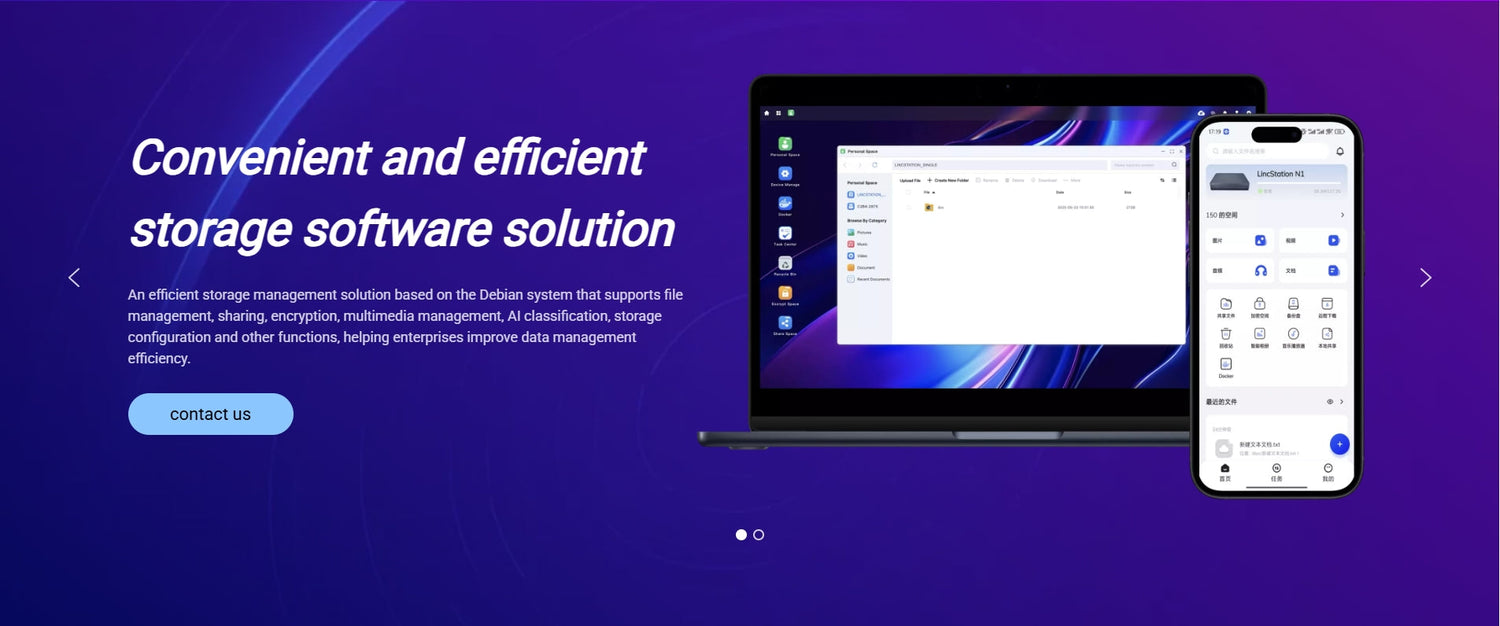In a world of remote work, digital privacy, and massive data growth, having a reliable and powerful NAS (Network Attached Storage) system has become essential—not just for tech enthusiasts, but also for families, freelancers, and businesses. At the heart of every great NAS setup is one key choice:
Which NAS operating system is best?
Whether you’re looking for the best NAS OS, a NAS with Windows OS, or the most intuitive home NAS operating system, this in-depth guide covers the leading options in 2025—including a closer look at LincOS, a rising star with cross-platform support.
Why Choosing the Right NAS OS Matters
The operating system (OS) is the brain of your NAS. A great NAS OS should:
- Provide fast and secure file storage and sharing
- Enable automated backups and snapshots
- Offer remote access with encrypted connections
- Run apps like media servers (Plex, Jellyfin), cloud sync (Nextcloud), Docker containers, and VMs
- Handle RAID arrays and support data redundancy
- Be easy to use while powerful enough for advanced users
Top NAS Operating Systems Compared
| OS Name | File System | Apps/Containers | Ease of Use | Platform Type | Cross-Platform? |
|---|---|---|---|---|---|
| TrueNAS Scale | ZFS | Docker + K8s | Medium | Open-source, x86 | ❌ |
| TrueNAS Core | ZFS | Jails | Medium | Open-source, x86 | ❌ |
| Unraid | XFS/Btrfs | Docker + VMs | High | Proprietary, x86 | ❌ |
| OpenMediaVault | EXT4/Btrfs | Docker + Plugins | High | Open-source, x86 | ❌ |
| Synology DSM | EXT4/Btrfs | Docker + Apps | Very High | Synology-only | ❌ |
| QNAP QTS | EXT4/Btrfs | Docker + Apps | Very High | QNAP-only | ❌ |
| Windows Server | NTFS | Hyper-V, SMB | High | Proprietary, x86 | ❌ |
| LincOS | EXT4/Btrfs | Docker + Web UI | Very High | Cross-platform + NAS | ✅ Web, Win, macOS, iOS, Android, Linux |
1. LincOS – Best for Cross-Platform, Private Cloud NAS
LincOS is a modern NAS operating system built on Debian Linux. It’s designed to make powerful NAS features accessible across multiple platforms—with official clients for: Web (browser-based access),Windows,macOS, Android, iOS, Linux
Key Features
- RAID management, disk pooling
- File sharing via SMB/NFS/WebDAV
- Encrypted remote access via LincAccess
- Media playback & AI photo classification
- Docker container support
- One-click backups and scheduled snapshots
- App integration: Nextcloud, Plex, Resilio Sync, etc.
Installation
LincOS supports both pre-installed systems (e.g., LincStation N2) and DIY NAS devices.
NAS Device Installation
- Download LincOS ISO from Download Page
- Flash to USB drive (using Rufus or dd)
- Boot from USB on your NAS hardware
- Run ./migrate (clean install) or ./upgrade (retain data)
- Reboot and access via browser (Web UI)
LincAccess (Remote Access)
Available for:
- Windows/macOS/Linux – Native apps and Docker images
- Android/iOS – Mobile apps with encrypted login
- Enables secure access to NAS over the internet with port mapping and real-time device control
Who Should Use LincOS?
- Photographers who need private cloud photo management
- Home users who want simplicity + security
- Tech-savvy users who want Docker, RAID, 10GbE in one box
- Great match with compact, low-power NAS like LincStation N2
2. TrueNAS SCALE/Core – Best for ZFS Power Users
Built by iXsystems, TrueNAS is trusted in enterprise and home lab environments.
- TrueNAS Core: FreeBSD-based, mature and stable
- TrueNAS SCALE: Debian-based, Docker/K8s support
Features
- ZFS file system (with snapshots, replication, compression)
- Easy-to-use Web GUI
- Native support for SMB/NFS/AFP/iSCSI
- Advanced app catalog (Nextcloud, Plex, etc.)
Use Case
- Ideal for users who need ZFS + RAID-Z
- Suited for large media libraries or critical business backups
- Requires decent hardware (ECC RAM recommended)
3. Unraid – Best for Media Servers & App Hosting
Unraid is a flexible, user-friendly NAS OS that excels in Plex servers, Docker apps, and VM hosting.
Features
- Parity-based storage (not traditional RAID)
- Mix drive sizes and formats
- VM support with GPU passthrough
- Vast Docker catalog
Use Case
- Home labs
- Plex + Jellyfin media streaming
- Docker enthusiasts
- DIY NAS builders who want total flexibility
4. OpenMediaVault – Best Lightweight Linux NAS OS
OpenMediaVault (OMV) is a Debian-based NAS OS known for:
- Simple Web UI
- Plugin system (SnapRAID, Plex, DLNA, Rsync)
- Docker support via omv-extras plugin
- Low resource footprint
Best for low-power servers or Raspberry Pi NAS builds.
5. NAS with Windows OS – When You Need Windows Integration
You can run a NAS with Windows Server Essentials, Windows Storage Server, or even Windows 11 Pro (with file sharing and Hyper-V enabled).
Advantages
- Familiar Windows interface
- Full NTFS and SMB control
- Active Directory and Hyper-V integration
- Ideal for small businesses or schools
Drawbacks
- High resource usage
- Requires paid licenses
- No native snapshot/RAID tools
- Less suitable for 24/7 headless operation
6. Synology DSM & QNAP QTS – Best Turnkey NAS OS
These proprietary systems offer polished experiences:
- App stores with hundreds of applications
- Built-in backup, surveillance, productivity tools
- Mobile and desktop clients
- Easy RAID setup and volume management
- Great for home and SMB users
But they're locked to Synology or QNAP hardware.
Summary Comparison Table
| Feature / OS | LincOS | TrueNAS Scale | Unraid | OpenMediaVault | Windows Server | Synology/QNAP |
|---|---|---|---|---|---|---|
| File System | EXT4/Btrfs | ZFS | XFS | EXT4/Btrfs | NTFS | EXT4/Btrfs |
| App Support | Docker, Plex, Nextcloud | Docker/K8s | Docker + VMs | Plugins, Docker | Windows apps | Apps + Docker |
| Ease of Use | ⭐⭐⭐⭐⭐ | ⭐⭐⭐ | ⭐⭐⭐⭐ | ⭐⭐⭐⭐ | ⭐⭐⭐ | ⭐⭐⭐⭐⭐ |
| Remote Access | LincAccess + HTTPS | VPN/SSH | OpenVPN | DDNS + VPN | RDP + SMB | QuickConnect |
| Best For | Cross-platform users | ZFS & redundancy | Plex + Docker | Lightweight setups | MS-only networks | Plug & play NAS |
| Hardware | Any (incl. N2) | DIY/server-grade | DIY | Any | High power | Vendor locked |
Security Tips for Any NAS OS
Regardless of your OS, follow these best practices:
- Use strong admin passwords + 2FA
- Enable HTTPS and VPNs for remote access
- Regularly update the OS and apps
- Set up snapshots + replication
- Monitor disk health and SMART data
- Don’t expose SMB/NFS directly to the internet
Final Thoughts: Which NAS OS Is Best in 2025?
- Best for General Users: LincOS – for ease, flexibility, and full platform access
- Best for Power Users: TrueNAS SCALE – for ZFS, Docker, and scalable storage
- Best for Plex & Media: Unraid – for Docker + VM support
- Best for Light Devices: OpenMediaVault – for Raspberry Pi, low-power boxes
- Best for Windows Workflows: Windows Server – only if AD/Hyper-V needed
- Best Plug & Play: Synology DSM / QNAP QTS – simple, polished, but hardware locked




Leave a comment
All comments are moderated before being published.
This site is protected by hCaptcha and the hCaptcha Privacy Policy and Terms of Service apply.